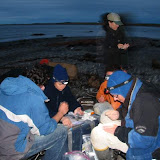Chile - Bahia Lomas, Tierra del Fuego, February 1, 2007

In as good condition as one can muster coming out of the field Carmen, Humphrey, Ricardo and I met with the administrator of the Province of Primavera, Ivan Herrera, in his office in Cerro Sombrero. Ivan is the deputy mayor of an area that covers much of the Chilean portion of Tierra del Fuego; it is nearly the size of NJ but with a relatively tiny human population. We came to discuss the new biological research center after considerable discussion amongst ourselves as to its location, type and strategic direction.
We proposed the center as a new bird observatory on the shore of the Strait of Magellan near the ferry terminal to be called the “Tierra del Fuego Bird Observatory”. It would have three main objectives: First to provide a logistical platform on which to focus research and survey on all bird species on the island of Tierra del Fuego with particular emphasis on shorebirds and the red knot. It would be equipped with basic accommodation and a lab and would provide an invaluable base camp for pioneering bird study in the region. Second the Observatory would become a gateway – a starting point – for all those interested in birding the Island (researchers and birders alike) from Bahia Azul in the north to Ushuaia in the south. This would be facilitated by our proposal to locate the Observatory at the old ferry terminal just one km from the current ferry. Third the Observatory would provide a logistical base for student exchange between the US (and other countries) and this section of Chile. Dan Hernandez of Stockton University has already begun to create just such a program.
Ivan enthusiastically supported our proposal and we spent the rest of the meeting developing a list of jobs and a timeline for the project. The mayor has already offered his support by offering to move an existing vacant house to the site. We would use project money from the Neotropical Bird Conservation Act Fund and Manomet Bird Observatory to restore the building, provide water, power and drainage systems as well as furnishings and equipment.
We will develop the project in more detail with a formal proposal, but our vision is to staff the observatory for at least the six months centered on the Austral summer. This will cover the local breeding season, as well as the period when migrants from North America are here (i.e. from fall to spring in the Northern Hemisphere).
In the afternoon the team surveyed the entire shore of Bahia Lomas and roosting sites on both sides of the Strait to provide a comparison with the aerial count. Mark and Ricardo covered the eastern part of the bay using the ATV and counted 4,650 knots, Mandy, Carmen, Steve, Sergio and Gabriela surveyed the west shore and found 1,159 knots. Humphrey and I surveyed known roosting sites on the north and south side of the Strait and found 3,250 knots. Altogether our count indicated a population of just over 9,000.
Late on Wednesday we made our second and last cannon net catch in Tierra del Fuego. Although trapping Red Knots is our primary goal, Carmen needed a sample of White-rumped Sandpipers in order to collect blood and feathers for disease and isotope studies. The SAG biologists were also with us to sample birds for avian influenza. We finally fired over about 150 white-rumps and finished processing at 11:00 pm.


0 Comments:
Post a Comment
Subscribe to Post Comments [Atom]
<< Home